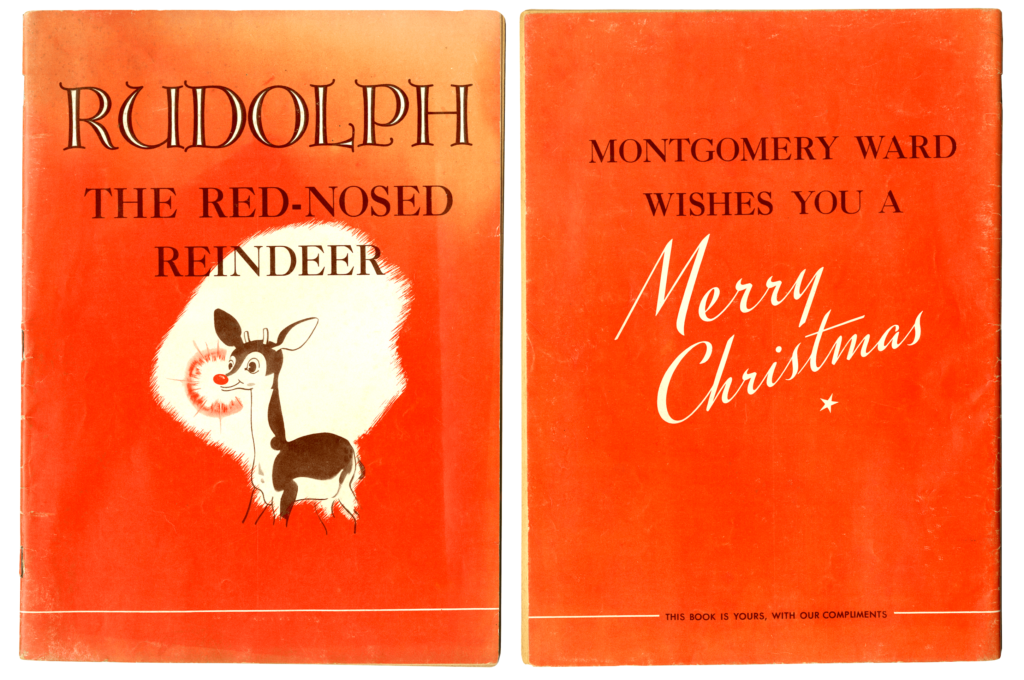
Branding the Holidays
How Coca-Cola and Montgomery Ward Shaped Christmas
The iconic image of Santa Claus as a jolly man in a red suit is a deeply ingrained part of Christmas culture. So too, Rudolph the Red-Nosed Reindeer is a character beloved by many, synonymous with Christmas and the spirit of the holidays. Interestingly, few people know that the widely recognized depiction of Old Saint Nick and the whimsical tale of a misfit caribou with a severe case of rhinitis were born from the marketing tactics of an iconic soft drinks company and a department store pioneer.
From Sleigh Bells To Soda Pop
The Santa we know today — with his cherry cheeks, white beard, and red outfit — was popularized largely through Coca-Cola’s advertising campaigns. Historically, Santa Claus is derived from St. Nicholas, a 4th-century bishop known for his generosity, and various other folkloric figures such as the British character Father Christmas and the Dutch Sinterklaas.
Before Coca-Cola’s involvement, Santa’s portrayal varied widely. In early representations, Santa was often depicted as a stately, and serious bishop wearing traditional clerical robes. In the 19th century, particularly in America, Santa began to take on a more secular and whimsical character, with some illustrations showing him as a tall, gaunt figure, while others depicted him as an elf-like character. His attire during this period was inconsistent and could vary dramatically. Images and descriptions from the time show him in a variety of colors including tan, green, blue, and red. His outfit could range from a long, fur-lined robe to a shorter coat, and he was sometimes shown wearing a “Norse” style hat or a hood instead of the now-familiar hat with a pom-pom.
The story of Coca-Cola and Santa Clause began in the 1930s when the company sought to increase winter sales. They decided to use the image of Santa Claus in their advertisements, hoping to evoke feelings of warmth, comfort, and cheer that would encourage consumers to associate their cold drink with the cozy holiday season. The company commissioned illustrator Haddon Sundblom to create images of Santa for their advertisements. Sundblom’s depiction was based on the poem “A Visit from St. Nicholas” (more commonly known as “‘Twas the Night Before Christmas”) by Clement Clarke Moore, which described Santa as a warm, friendly, and plump character.

Sundblom’s Santa debuted in 1931 and was an immediate hit. The paintings showed Santa as a human rather than the previously common elfin figure, with rosy cheeks, a soft, friendly smile, and an unmistakable red outfit that mirrored Coca-Cola’s branding. These images were so appealing and so widely circulated that they became the standard depiction of Santa Claus globally. Each year, new images were released, showing Santa in various settings, often enjoying a Coke, which helped cement the connection between Coca-Cola and the Christmas holiday.
The success of this campaign was multi-faceted. Firstly, it tapped into the public’s desire for nostalgia and comfort during a time of year that is deeply associated with warmth and family. Secondly, it linked Coca-Cola, a beverage not naturally associated with winter, with Christmas, thus boosting sales during a typically slow time of year for cold beverage manufacturers. Lastly, it was an early and outstanding example of brand association, linking Coca-Cola’s red and white color scheme with the now universally recognized outfit of Santa Claus.
Then One foggy Christmas Eve
The story of Rudolph is another interesting intersection of creativity and commerce, showcasing how a character designed for promotional purposes became a staple of Christmas folklore.
Rudolph’s story began in 1939 when Robert L. May, a copywriter at the Montgomery Ward department store, was tasked with creating a Christmas storybook that the store could give away to shoppers as a promotional item. The goal was to attract more customers to the store during the holiday season and to save money by creating their own giveaway instead of buying and distributing coloring books from elsewhere.
May, drawing on his own experiences of being shy and somewhat of an outcast, and inspired by the tale of “The Ugly Duckling,” came up with Rudolph, a young reindeer with a shiny red nose that was different from all the other reindeers. Rudolph was initially teased by his peers for his bright red nose, but his uniqueness eventually became his strength. On one particularly foggy Christmas Eve, Santa Claus realizes that Rudolph’s glowing nose could help him navigate through the mist and deliver presents to children around the world. Rudolph becomes a hero, leading Santa’s sleigh and earning the respect of all the other reindeer.

The story was a massive success. Montgomery Ward distributed 2.4 million copies of the Rudolph booklet that first year. Despite wartime paper shortages limiting its distribution over the next few years, by the end of 1946, the store had given away more than six million copies of the Rudolph booklet. Rudolph’s popularity continued to soar when May’s brother-in-law, Johnny Marks, wrote a song based on the story in 1949. The song “Rudolph the Red-Nosed Reindeer” was recorded by Gene Autry and became a massive hit, further cementing Rudolph’s place in Christmas culture.
Rudolph’s creation as part of a marketing campaign is a prime example of how commercial intentions can sometimes lead to enduring and beloved cultural icons. What began as a promotional giveaway to lure shoppers became a story that resonated with millions, teaching lessons about acceptance, perseverance, and how being different can be a strength rather than a weakness. Rudolph’s story is not just a tale of a red-nosed reindeer but also a narrative about the unexpected and far-reaching impact of a creative marketing idea. Whether it was the book, the song, or the numerous television specials and movies that followed, Rudolph the Red-Nosed Reindeer remains a cherished part of Christmas tradition, proving that sometimes, a marketing campaign can create something that lasts well beyond its initial commercial intent.
Both Santa Claus and Rudolph have transcended their commercial origins to become integral parts of the Christmas narrative. These characters reflect broader themes of kindness, generosity, and the importance of embracing one’s individuality — values that resonate deeply during the holiday season. However, their stories also demonstrate how marketing can shape and define cultural traditions. The influence of these campaigns extends beyond mere consumerism; they have contributed to the collective understanding and celebration of Christmas around the world.
Happy Holidays!



